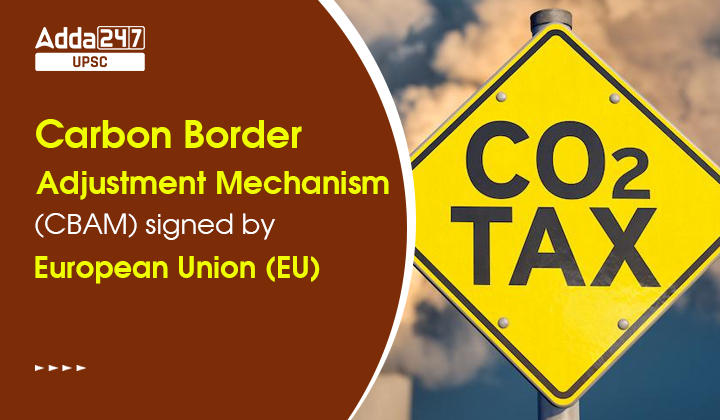Table of Contents
Carbon Border Adjustment Mechanism (CBAM): The CBAM is a policy tool proposed by the European Union (EU) to address carbon leakage and promote fair competition. It aims to place a carbon price on imported goods based on their embedded carbon emissions, similar to the emissions cost that EU producers face under the EU Emissions Trading System (EU ETS). Carbon Border Adjustment Mechanism (CBAM) is also important UPSC Prelims Exam and UPSC Mains Exam (GS Paper 2- International Relations; GS Paper 3- Environment and Ecology).
Carbon Border Adjustment Mechanism (CBAM) in News
Recently, the co-legislators at the European Commission signed the Carbon Border Adjustment Mechanism (CBAM). Carbon Border Adjustment Mechanism (CBAM) tool has been hailed as a significant milestone in establishing an equitable cost for the carbon emissions associated with the production of carbon-intensive goods entering the European Union. Its purpose is to incentivize cleaner industrial practices not only within the EU but also in countries outside the EU.
Carbon Border Adjustment Mechanism (CBAM) Explained
The Carbon Border Adjustment Mechanism (CBAM) pertains to the scenario where EU manufacturers relocate carbon-intensive production to countries that have less stringent climate policies, leading to the substitution of EU-manufactured goods with imports that have a higher carbon footprint. Its primary objective is to avert ‘carbon leakage’.
- Starting from 2026, once CBAM is fully implemented, importers in the European Union (EU) will be required to purchase carbon certificates equivalent to the carbon price that would have been applicable if the imported product had been produced within the EU, adhering to its carbon pricing regulations.
- On the other hand, if a non-EU producer already pays a price or tax for the carbon emissions associated with the production of the imported goods, either in their home country or elsewhere, the corresponding cost would be deducted for the EU importer.
- The European Commission, in collaboration with the relevant authorities of the member states, will be responsible for reviewing and verifying the declarations made by importers, as well as managing the central platform for the sale of CBAM certificates.
- Importers will be required to declare annually, by the end of May, the quantity of goods imported into the EU during the previous year, along with the embedded emissions associated with those goods.
Need of Carbon Border Adjustment Mechanism (CBAM)
The primary objective is to prevent carbon leakage and simultaneously promote the adoption of environmentally friendly manufacturing practices by producers in non-EU countries.
- Additionally, it aims to establish fair competition between imported goods and products manufactured within the EU.
- This initiative is an integral part of the broader European Green Deal, which strives to achieve a 55% reduction in carbon emissions by 2030, compared to 1990 levels, and transform Europe into a climate-neutral continent by 2050.
Impact on Non-EU Countries
Initially, the Carbon Border Adjustment Mechanism (CBAM) will be applicable to specific goods and precursors that have a high carbon footprint and are at risk of carbon leakage. This includes sectors such as cement, iron and steel, aluminium, fertilizers, electricity, and hydrogen.
- In a report published in 2021, the United Nations Conference on Trade and Development (UNCTAD) identified Russia, China, and Turkey as the countries most exposed to the CBAM due to their significant exports to the European Union (EU) in these sectors.
- Among developing countries, India, Brazil, and South Africa were projected to be the most affected based on their trade relationships with the EU, while Mozambique was identified as the most vulnerable least-developed country.
- It is worth noting that the EU countries collectively account for approximately 14% of India’s total export mix, which includes products like steel and aluminium.
Impact of CBAM on India
Between 2019 and 2021, India’s exports in the five sectors affected by the Carbon Border Adjustment Mechanism (CBAM) represented less than 2% of its total exports to the European Union (EU). While the immediate impact of the regulation may seem limited, its long-term consequences could be severe for several reasons.
- Firstly, considering that the EU is India’s third-largest trading partner and given India’s projected growth, exports (including in CBAM sectors) are expected to increase significantly.
- Secondly, the scope of CBAM is likely to expand beyond its current sectors to include additional industries.
- Due to the higher carbon intensity of Indian products compared to their European counterparts, the imposed carbon tariffs would be relatively higher, rendering Indian exports considerably less competitive.
- Lastly, as international climate policies, including CBAM, prompt other countries to adopt similar regulations, it will have a significant impact on India’s trading relationships and balance of payments.
Conclusion
During the inaugural EU-India Trade and Technology Council, it was announced in a joint statement that both sides have agreed to enhance their engagement on carbon border measures, indicating a willingness to intensify discussions on this topic.
India Plans Uniform Carbon Trading Market



 TSPSC Group 1 Question Paper 2024, Downl...
TSPSC Group 1 Question Paper 2024, Downl...
 TSPSC Group 1 Answer key 2024 Out, Downl...
TSPSC Group 1 Answer key 2024 Out, Downl...
 UPSC Prelims 2024 Question Paper, Downlo...
UPSC Prelims 2024 Question Paper, Downlo...
